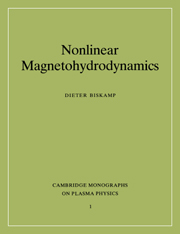Book contents
- Frontmatter
- Contents
- Preface
- 1 Introduction
- 2 Basic properties of magnetohydrodynamics
- 3 Magnetostatic equilibria
- 4 Normal modes and instability
- 5 Nonlinear evolution of MHD instabilities
- 6 Magnetic reconnection
- 7 MHD turbulence
- 8 Disruptive processes in tokamak plasmas
- 9 Dynamics of the reversed-field pinch
- 10 Solar flares
- Outlook
- References
- Index
1 - Introduction
Published online by Cambridge University Press: 15 December 2009
- Frontmatter
- Contents
- Preface
- 1 Introduction
- 2 Basic properties of magnetohydrodynamics
- 3 Magnetostatic equilibria
- 4 Normal modes and instability
- 5 Nonlinear evolution of MHD instabilities
- 6 Magnetic reconnection
- 7 MHD turbulence
- 8 Disruptive processes in tokamak plasmas
- 9 Dynamics of the reversed-field pinch
- 10 Solar flares
- Outlook
- References
- Index
Summary
Magnetohydrodynamics (MHD) describes the macroscopic behavior of electrically conducting fluids, notably of plasmas. However, in contrast to what the name seems to indicate, work in MHD has usually little to do with dynamics, or at least has had so in the past. In fact, most MHD studies of plasmas deal with magnetostatic configurations. This is not only a question of convenience — powerful mathematical methods have been developed in magnetostatic equilibrium theory — but is also based on fundamental properties of magnetized plasmas. While in hydrodynamics of nonconducting fluids static configurations are boringly simple and interesting phenomena are in general only caused by sufficiently rapid fluid motions, conducting fluids are often confined by strong magnetic fields for times which are long compared with typical flow decay times, so that the effects of fluid dynamics are weak, giving rise to quasistatic magnetic field configurations. Such configurations may appear in a bewildering variety of shapes generated by the particular boundary conditions, e.g. the external coils in laboratory experiments or the “foot point” flux distributions in the solar photosphere, and their study is both necessary and rewarding.
In addition to finding the appropriate equilibrium solutions one must also determine their stability properties, since in the real world only stable equilibria exist.
- Type
- Chapter
- Information
- Nonlinear Magnetohydrodynamics , pp. 1 - 7Publisher: Cambridge University PressPrint publication year: 1993



